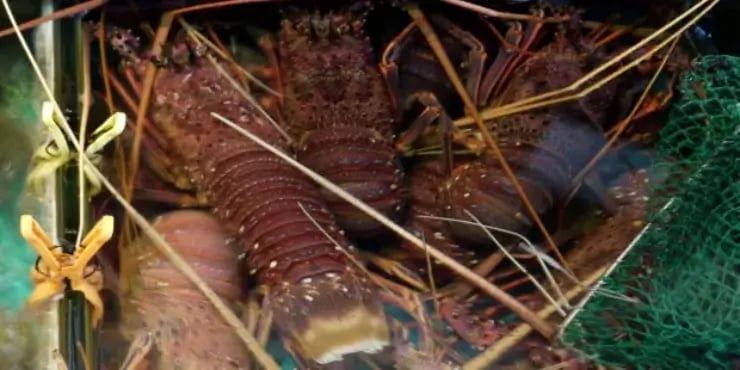Shrimp farms destroy sensitive mangrove forest ecosystems, salmon escape from designated aquaculture spots and spread parasites, fish trawlers leave nothing but empty seas behind and even organic fish farming could be unsustainable due to dependence on fish meal from wild catch. When it comes to seafood, the message transmitted across mainstream media channels is devastating: there is simply nothing left we can eat responsibly, be it from the wild or aquaculture. Does that mean we all have to go vegetarian? Well, in many cases, the good news is that fish performs better than meat, when it comes to per kilogram carbon footprint. And just like forestry, a sustainable harvest is possible for harvest from the wild as well as for aquaculture. It all depends on the way we do it. As with medicine, the question is one of dosage. So, in what ways do humans interfere with formerly “untouched” ecosystems and what are the effects? The responsible consumer, hungry for serious information, gets a more positive impression once he or she is clear of the sensationalist fog of yet another apocalyptic edutainment piece and jumps into the world of reliable life cycle assessment. This is exactly what we start to do today: get into the details of the environmental impact of seafood. We’ll look at the actual emissions of both fishing and fish farming, explore the ways to harvest seafood in a sustainable manner, and scan through some science based publications to obtain more reliable information.

Catching a Fish Uses 12x More Energy Than There Are Calories in the Fish
Even when we leave out the important ethical issue of killing a being exclusively for culinary delight, one dilemma remains. Be it livestock from land or from sea, if breeding or catching living beings consumes so much more energy than the calories we get out of the food, why don’t we base our diet on vegetable protein? The answer to that has to be given on an individual basis. However, a sturdy criterion for decision-making can never be wrong. On average, global fisheries burn 12.5 times more energy in their engines “than the edible protein energy content of the resulting catch”, says The carbon footprint of fisheries leaflet (PDF) published by the North Sea Foundation. But that is an average figure. The more detailed we look at individual species, the more complex it gets. First of all, fuel efficiency highly depends on fishing gear and the targeted species. The diagram, below right (“Climate tracking…”), illustrates this.
Mackerel and Herring Score Best, If Consumed in Norway

The above, however, is only valid for the North Sea. This leads us to the second dimension that increases complexity. Exactly where the fish is caught, and where on earth you consume it, highly influences the overall environmental impact. In order to fully understand this point, nothing could be more appropriate than a look at the diagram to the right. Norway based Sintef, which claims to be the “largest independent research organization in Scandinavia”, published it in an effort to track the global warming potential of the country’s seafood. Norway, just behind China and ahead of Thailand, is the world’s second biggest exporter of seafood in terms of value (in terms of quantity, the countries of South East Asia, which export species with a lower market value, rank highest). The yellow portions describe the emissions due to feed production for aquaculture, whereas light blue refers to emissions from fishing vessels. You can clearly see how heavily air transport affects the climate. Each kg of fresh salmon from a fish farm in Norway sold in Tokyo causes 13.9 kg carbon dioxide equivalent emissions! If the same fresh salmon is sold in Oslo, emissions fall to 3.3 kg CO2eq per kg. Overland transport to Moscow by truck increases emissions by only 0.9 kg CO2eq. At the other end of the scale, the results for herring and mackerel are much better, mainly because they can be caught closer to the shore and thus require comparatively little fuel consumption by fishing vessels. They generate four times fewer emissions than the fresh salmon, when consumed in Moscow, because their freezing makes a more fuel efficient, but slower, transport possible (by boat).

2% of Global Oil Consumption for Fishing and Aquaculture
Frank Asche, author of the OECD report Green Growth in Fisheries and Aquaculture Production and Trade, estimates that 2% of the global oil consumption goes to fishing and aquaculture (see page 3 of the PDF). In his report, even though its name implies further growth, he recommends managing fishing grounds and reducing fishing vessel capacity. Not surprisingly, he mentions a well-known issue inhibiting progress in this field:
There is little doubt that discarding waste[s] significant resources, even though it is difficult to estimate the degree of discarding with much precision. Pauly et al. (2003) estimate that a quantity of fish equivalent to 30% of what is actually landed is discarded. […] (p.10)
For instance, in the Atlantic there are typically being caught 3 tonnes of shark, which is dumped, for each tonnes of swordfish. […] (p. 19)
It is natural to think that fishery managers’ effort are targeted at reducing overcapacity, discarding and other forms of wasteful behavior, and largely they are. However, it may come as a surprise that a number of countries also subsidise fishers directly and indirectly, exacerbating the environmental problems. (p. 10)
Reviewing subsidies in order to cut the environmentally harmful ones is also what NGOs like the North Sea Foundation call for. In the above mentioned leaflet (PDF) we read:
A change in fishing methods and gears can be promoted by removing environmentally harmful fuel subsidies and phasing out fuel tax exemption for fisheries, while at the same time providing financial and other incentives for alternative fishing techniques. The European Fisheries Fund could be used to facilitate the shift to new gear, and special quota or fishing zones for less fuel-intensive low-impact fisheries could be allocated.
Managing Plans: Instruments for Efficient Fishing
However, an exclusive focus on fishing techniques is insufficient. Asche has an entire chapter on exploitation which is definitely worth reading. He strongly calls for managment plans, an idea that has its origins as early as 1954. I allow myself to briefly cite the most striking paragraphs here.
If humanity succeeds in using the oceans more efficiently, this can be the largest single contributor to less pressure on marginal land and less deforestation on land. However, as this is largely a new way of using and interacting with the environment, increased aquaculture production and it’s interaction with wild fish is in many cases creating controversy and the industry’s environmental sustainability is challenged. […] (p. 3)
According to the FAO (2010), about half of the fish stocks are fully exploited, a third is overexploited or rebuilding and 15% is not fully exploited. There are different opinions with respect to the implications this has for the status of the world’s fish stocks, as it is not clear if it is good or not that a stock is fully exploited. However, there is general agreement that production from wild fisheries cannot increase significantly. The landings seem to have stabilised around 90 million tonnes (Figure 1), and to the extent that wild seafood resources are to contribute to economic growth, it must primarily be due to increased value added. (p.7)
Concerning the contents of these management plans, it has to be said that there is strong disagreement between the authorities that set fishing quotas on the one hand, and environmental groups on the other, when it comes to correct definition of sustainable exploitation. Authorities, influenced by industry lobbies, are naturally inclined to follow more optimistic livestock development scenarios than NGOs and nature conservationists.
Overfishing Consequence (1): Succession, not Vast Emptiness
But what happens down in the deep blue sea, when one species is over-fished? One thing that struck me while reading Asche’s report is the concept of naturally constant biomass in the oceans. As soon as one species is fished down, another one takes its place and spreads rapidly. If this is true, the term “fishing the oceans empty”, which can be found in virtually any semi-professional conservationist documentary on fishing, becomes completely inappropriate.
How much one can fish is limited because the main production is carried out by nature, and fishers are harvesting nature’s bounty. Hence, the fishing industry does not produce fish, it only harvests fish. As such, it can be regarded as the world’s last significant hunting or harvesting industry. The world’s oceans and waterways have a natural production capacity that cannot be exceeded.3 If one stock is fished down, it will largely be replaced by other species (Sanchirico and Wilen, 1998; Smith and Wilen, 2003). Hence, there are few cases where biomass production is severely reduced when a fish stock is significantly fished down. Rather, other species will exploit this opportunity to obtain food to thrive. Often the value of the harvest will be reduced as the new species are less desirable, but there are also examples of increased harvest value. One such example is when crustaceans took over for the cod in Atlantic Canada. However, there can often be social disturbances when one (group of) fish stock(s) is being fished down and the stocks of other species increase as different fishing gears, vessels and crews are often required. (p. 8)
Overfishing Consequence (2): Social Disaster
“Social disturbances”, in this context, seems more like a euphemism for preventable catastrophes than an appropriate term for an impact of overfishing. If you have seen Darwin’s Nightmare, your picture of how disappearing species influence local communities will certainly differ from mere disturbance. However sad it may be, fishing is no exception in the ever repeating “tragedy of the commons” story – people have been over-exploiting their living areas’ resources for millennia. Try googling Easter Island forest, for instance. Asche:
The tragedy of the commons is likely to take place for all unmanaged renewable natural resources, including fisheries. The basic problem is that the agents who are exploiting the resource, in our case the fishers, have no incentives to protect the resource (the fish stock). This leads to over exploitation, and the stock is fished down to low and possibly unsustainable levels. Because it is profitable for any fisher in the short run, this process attracts fishers and capital and normally leads to substantial overcapacity. This is the case for fisheries with large and modern vessels as well as fisheries with a large number of small coastal vessels. In principle, this process can be prevented with a good management system (Gordon, 1954). Unfortunately, there are few examples where a good management system was in place before the stocks had largely been fished down, and too often, management does not start before the stocks have collapsed (Hannesson, 1996; Wilen, 2000).

So are we lost? Are the apocalyptic edutainment stories, mentioned in the first paragraph, right after all?
Read more in part two of this article, to be published next week. Part two will evaluate whether a fish meal trap really exists for aquaculture that is dependent on wild fish catch to provide proteins. Can, or cannot, aquaculture be a solution for overfishing the oceans? We’ll also look at a detailed comparative LCA for seafood in Britain, find out what environmental product declarations for fish should include and ways for the fishing industry to go green. Stay tuned.
Article image by Moritz Bühner, taken in Hong Kong.





